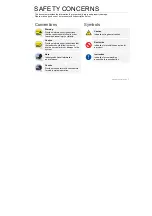
ENGLISH
10
A cold battery pack will charge at about half the rate
of a warm battery pack. The battery pack will charge
at that slower rate throughout the entire charging
cycle and will not return to maximum charge rate
even if the battery warms.
Important Safety Instructions for All
Battery Packs
When ordering replacement battery packs, be sure
to include the catalogue number and voltage.
The battery pack is not fully charged out of the
carton. Before using the battery pack and charger,
read the safety instructions below and then follow
the charging procedures outlined.
READ ALL INSTRUCTIONS
• Do not charge or use the battery pack
in explosive atmospheres, such as in the
presence of flammable liquids, gases or
dust.
Inserting or removing the battery pack
from the charger may ignite the dust or fumes.
•
Never force the battery pack into charger.
Do not modify the battery pack in any way
to fit into a non-compatible charger as
battery pack may rupture causing serious
personal injury.
• Charge the battery packs only in designated
D
E
WALT chargers.
• DO NOT
splash or immerse in water or other
liquids.
• Do not store or use the tool and battery
pack in locations where the temperature
may reach or exceed 40 ˚C (105 °F) (such as
outside sheds or metal buildings in summer).
• For best results, make sure the battery pack is
fully charged before use.
WARNING:
Never attempt to open
the battery pack for any reason. If
the battery pack case is cracked or
damaged, do not insert it into the
charger. Do not crush, drop or damage
battery pack. Do not use a battery
pack or charger that has received a
sharp blow, been dropped, run over
or damaged in any way (e.g., pierced
with a nail, hit with a hammer, stepped
on). Electric shock or electrocution may
result. Damaged battery packs should
be returned to the service centre for
recycling.
CAUTION: When not in use, place
tool on its side on a stable surface
where it will not cause a tripping or
falling hazard.
Some tools with large
battery packs will stand upright on the
battery pack but may be easily knocked
over.
SPECIFIC SAFETY INSTRUCTIONS FOR LITHIUM ION
(Li-Ion)
• Do not incinerate the battery pack even if it
is severely damaged or is completely worn
out.
The battery pack can explode in a fire.
Toxic fumes and materials are created when
lithium ion battery packs are burned.
• If battery contents come into contact with
the skin, immediately wash the area with
mild soap and water.
If the battery liquid gets
into the eye, rinse water over the open eye for
15 minutes or until irritation ceases. If medical
attention is needed, the battery electrolyte
is composed of a mixture of liquid organic
carbonates and lithium salts.
• Contents of opened battery cells may cause
respiratory irritation.
Provide fresh air. If
symptoms persists, seek medical attention.
WARNING:
Burn hazard. Battery liquid
may be flammable if exposed to spark
or flame.
Battery Pack
BATTERY TYPE
The DCH143 operates on 14.4 V battery packs. The
DCH243, DCH253 and DCH254 operate on 18 V
battery packs.
The DCB140, DCB141 or DCB142 battery packs
(14.4 V) may be used on the DCH143.
The DCB180, DCB181, DCB182 or DCB183
battery packs (18 V) may be used on the DCH243,
DCH253 and DCH254.
Storage Recommendations
1. The best storage place is one that is cool and
dry away from direct sunlight and excess heat
or cold. For optimum battery performance and
life, store battery packs at room temperature
when not in use.
2. For long storage, it is recommended to store a
fully charged battery pack in a cool, dry place
out of the charger for optimal results.
NOTE:
Battery packs should not be stored
completely depleted of charge. The battery pack will
need to be recharged before use.
Summary of Contents for XR Li-ION DCD990
Page 1: ...DCD932 DCD937 DCD990 DCD995 ...
Page 3: ...1 Figure 1 e c d b a f i Figure 2 i h l i h k j m DCD990 h g ...
Page 4: ...2 Figure 6 Figure 8 Figure 7 d e f Figure 3 Figure 4 Figure 5 Figure 9 e f g n ...
Page 197: ...195 ...
Page 198: ...196 ...
Page 199: ...197 ...
Page 201: ...DCH143 DCH243 DCH253 DCH254 ...
Page 202: ...II English original instructions 4 Copyright DEWALT ...
Page 203: ...1 Figure 1 e a c b h f d j i g k Figure 2 b m l o DCH143 DCH253 DCH254 ...
Page 204: ...2 Figure 3 Figure 5 f g Figure 4 m l f n o ...









































